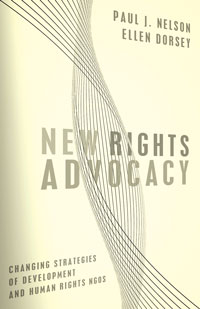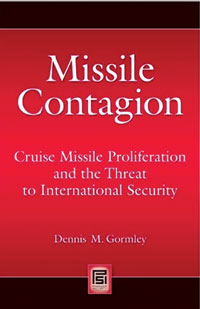On the Pitt Bookshelf
Paul J. Nelson explores non-governmental organizations’ blurring of approaches
 Dozens of nongovernmental organizations (NGOs) emerged after World War II, committed to improving the lives of the world’s most vulnerable people. Some focused on protecting human rights while others were dedicated to satisfying basic economic needs. Both approaches had distinctive methods, missions, and emphases, but in the 1980s, the dividing line began to blur.
Dozens of nongovernmental organizations (NGOs) emerged after World War II, committed to improving the lives of the world’s most vulnerable people. Some focused on protecting human rights while others were dedicated to satisfying basic economic needs. Both approaches had distinctive methods, missions, and emphases, but in the 1980s, the dividing line began to blur.
Coauthored by Paul J. Nelson, a professor and division director of international development in Pitt’s Graduate School of Public and International Affairs, New Rights Advocacy: Changing Strategies of Development and Human Rights NGOs (Georgetown University Press, 2008), is one of the first books to track the growing intersection and overlap of human rights and development NGOs. The authors introduce a concept called “new- rights advocacy” as they draw on rich case studies of internationally well-known NGOs. New-rights advocacy includes three main trends: the embrace of human rights-based approaches by influential development NGOs; the adoption of active economic and social rights agendas by major international human-rights NGOs; and the surge of work on economic and social policy through a human-rights lens by specialized human-rights NGOs and social movement campaigns.
—Amanda Leff
Dennis Gormley focuses on cruise missile proliferation
 Missile Contagion: Cruise Missile Proliferation and the Threat to International Security (Praeger Security International, 2008), by Dennis Gormley, explains the epidemic of cruise missile proliferation. The author, a senior lecturer in security and intelligence studies in Pitt’s Graduate School of Public and International Affairs, uses the context of ballistic missile proliferation to explain why cruise missiles are beginning to spread widely. He argues that a series of rapid and surprising developments since 2005 suggest that the proliferation of missiles capable of delivering either weapons of mass destruction or highly accurate conventional payloads is approaching a critical threshold. Literally and figuratively flying under the radar, land-attack cruise missiles add a dangerous new dimension to protecting U.S. security interests and preventing regional military instability, explains Gormley. He asserts that cruise missiles will not replace ballistic missiles—when used together they could severely test even the best missile defenses. Worse yet, Gormley argues, land-attack cruise missiles are increasingly being linked to preemptive strike doctrines, which are fueling regional arms races and crisis instability.
Missile Contagion: Cruise Missile Proliferation and the Threat to International Security (Praeger Security International, 2008), by Dennis Gormley, explains the epidemic of cruise missile proliferation. The author, a senior lecturer in security and intelligence studies in Pitt’s Graduate School of Public and International Affairs, uses the context of ballistic missile proliferation to explain why cruise missiles are beginning to spread widely. He argues that a series of rapid and surprising developments since 2005 suggest that the proliferation of missiles capable of delivering either weapons of mass destruction or highly accurate conventional payloads is approaching a critical threshold. Literally and figuratively flying under the radar, land-attack cruise missiles add a dangerous new dimension to protecting U.S. security interests and preventing regional military instability, explains Gormley. He asserts that cruise missiles will not replace ballistic missiles—when used together they could severely test even the best missile defenses. Worse yet, Gormley argues, land-attack cruise missiles are increasingly being linked to preemptive strike doctrines, which are fueling regional arms races and crisis instability.
Gormley explores the role of three factors in shaping the spread of cruise missiles: specialized knowledge needed for missile development; narrative messages about reasons for acquiring cruise missiles; and norms of state behavior about missile nonproliferation policy and defense doctrine. He also addresses the policy adjustments needed to stifle the spread of cruise missiles.
—Amanda Leff
A look at the development of the European Union’s air-transport policy
 A Europe of the Air? The Airline Industry and European Integration (Rowman and Littlefield, 2008) by Martin Staniland offers the first full study of the development of the European Union’s air-transport policy. Though crucial to both globalization and regional integration, the airline industry was one of the last to be liberalized in the process of European integration. According to Staniland, professor of international relations in Pitt’s Graduate School of Public and International Affairs, the creation of a single market in air transport was met with sharp political disputes, unreconstructed nationalism, and persistent foot-dragging.
A Europe of the Air? The Airline Industry and European Integration (Rowman and Littlefield, 2008) by Martin Staniland offers the first full study of the development of the European Union’s air-transport policy. Though crucial to both globalization and regional integration, the airline industry was one of the last to be liberalized in the process of European integration. According to Staniland, professor of international relations in Pitt’s Graduate School of Public and International Affairs, the creation of a single market in air transport was met with sharp political disputes, unreconstructed nationalism, and persistent foot-dragging.
Exploring the long struggle to create a “Europe of the Air” through both regulatory change and airline strategizing, Staniland examines the political bargains that have shaped a highly fragmented industry and its regulation. He argues that, rather than focusing on directives and regulations issued from Brussels, students of integration should examine the ways in which the contentious interaction between leaders of an industry and relevant politicians and officials creates distinctive “market orders.”
Such market orders enable firms to minimize the risks inherent in business, while allowing regulators to pursue the mandates of their organizations and to realize their notions of public interest. Economic integration is therefore an often painful struggle to create a market order defined both by regulatory jurisdiction and by competition among firms. A unique case study in industrial policy, this book has been designed for students of aviation as well as for scholars interested in regulatory change and European integration.
—Amanda Leff
Other Stories From This Issue
On the Freedom Road

Follow a group of Pitt students on the Returning to the Roots of Civil Rights bus tour, a nine-day, 2,300-mile journey crisscrossing five states.
Day 1: The Awakening
Day 2: Deep Impressions
Day 3: Music, Montgomery, and More
Day 4: Looking Back, Looking Forward
Day 5: Learning to Remember
Day 6: The Mountaintop
Day 7: Slavery and Beyond
Day 8: Lessons to Bring Home
Day 9: Final Lessons

